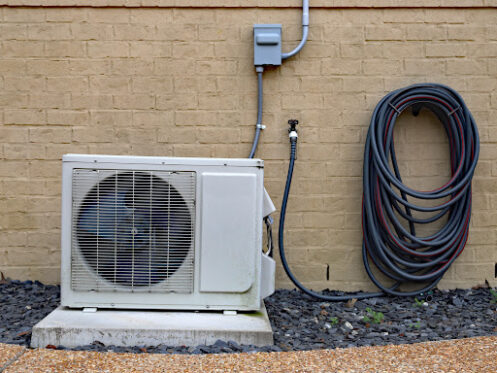
If you’re considering installing a ductless system in your home, one of the most important factors is sizing. Choosing the right size ductless system for your home’s square footage can greatly affect energy efficiency, comfort, and overall performance. Getting it right the first time will save you a significant amount of time and money. Keep reading to learn how to choose the right size system for your home.
Measure Your Home’s Square Footage
The first step in sizing your mini split is to determine the square footage of your home. To do this, you first need to grab a tape measure and measure the length and width of each room in your home. Next, you want to multiply these two numbers together to get the square footage of each room. Finally, add up the square footage of all the rooms in your home to get the total square footage. This total square footage will help you determine the BTU (British Thermal Units) rating you need for your mini split.
Calculate Your BTU Needs
Once you have your total square footage and climate zone, you can calculate your BTU needs. Generally, you’ll need about 30 BTUs per square foot of living space. However, if you live in a particularly hot or cold climate zone, you may need more or less than this. For example, if you live in the South, you may need up to 40 BTUs per square foot of living space.
Other Factors to Consider
In order to correctly size your ductless system, you need to consider more than just the square footage of the house. Here are some other things to keep in mind when choosing your system.
Climate
The climate plays a significant role in determining the size of the ductless mini split you should install. If you live in a colder climate, you will need a larger, more powerful mini-split to keep your space warm. The size of the mini split is measured in tons, where one ton equals 12,000 BTUs per hour. A mini split with a higher BTU rating will cool or heat a larger area more efficiently. Choosing the right size mini-split for your needs is crucial, as an undersized system will need help to keep your space comfortable, while an oversized system will save energy and money.
If you live in a warmer climate, you will need a smaller ductless mini-split system as you will mostly be using it for cooling. A smaller mini-split will be more cost-effective, using less energy to cool your space. Typically, a 1-ton mini-split system is perfect for cooling a room up to 400 square feet, while a 2-ton system is ideal for cooling up to 800 square feet.
Humidity is another crucial factor to consider when selecting the size of your ductless mini split. You will require a larger system to keep your space comfortable in areas with high humidity levels. A larger system will help to reduce humidity, keeping the air dryer and more comfortable. Conversely, a smaller system may be unable to keep up with the humidity, leading to damp and uncomfortable conditions.
Age and Insulation
Age is an essential factor to consider when sizing a ductless mini-split system. Older homes are less energy-efficient than newer models and must meet modern construction standards. Older homes have inadequate insulation, drafty windows and doors, and poor air circulation, leading to higher energy costs and reduced heating and cooling efficiency. Therefore, older homes require more energy to heat and cool. To determine the appropriate size of your ductless mini split, you must consider the age of your home and its overall energy efficiency. An expert HVAC technician can help you determine the right size for your home or office.
The insulation of your home or office is another critical factor that affects ductless mini-split sizing. The better the insulation in your home, the smaller the ductless mini split you require, and vice versa. Good insulation helps retain heat during winter and cool air during summer, reducing energy costs, increasing energy efficiency, and enhancing occupant comfort. If your home or office has adequate insulation, you can choose a smaller ductless mini-split system without sacrificing heating and cooling efficiency.
Ceiling Height
The higher the ceiling, the more significant the room’s cubic footage will be, which means there will be more air to heat or cool. This extra space can cause the system to work harder than it should, resulting in higher operating costs. Therefore, choosing the right BTU capacity that aligns with the ceiling height and room size is essential.
If the ceiling height is between eight and nine feet, it will not significantly affect the BTU capacity, and you can follow the standard sizing rule of thumb of 1 ton per every 400 square feet of space. However, more than a rule of thumb is required for ceiling heights higher than nine feet. A general rule of thumb is to add 600 BTUs of cooling capacity for every additional foot of ceiling height above nine feet. Thus, if your room has a ceiling height of 14 feet, you would need to increase the BTU capacity of the mini-split system.
It’s worth noting that modern ductless mini-split systems have features that help compensate for high ceiling heights. Some models have the facility for wider airflows, which delivers more air to cover broader areas. Also, high static pressure fans in mini splits help optimize the system’s performance regardless of the ceiling height. Consult with your contractor to determine the right system for your specific room height and size.
The Placement and Size of Windows
Windows are an essential component for measuring the size of the ductless system needed. The size of your windows will affect your unit’s capability to heat and cool the room. The larger the window, the more the unit will strain.
The level of sunlight plays a significant role in determining the size of your ductless system. The amount of sunlight that streams into your home will raise the temperature. The warmer your home, the more the system will strain to maintain the indoor temperature. Keep this in mind when choosing the right ductless system for your home.
Contact the Professionals
Black-Haak is committed to helping homeowners find the perfect ductless system. Sizing is essential when choosing a ductless system, and we’ve got you covered. We consider all of the necessary factors to recommend the perfect size and type of system for your home. We also offer heating and air conditioning installation, maintenance, and repairs. In addition to HVAC services, our plumbers handle all types of plumbing repairs and installations, including drains, water heaters, showers, garbage disposals, and sump pumps. Our electricians can service and install electrical panels, generators, EV charging stations, ceiling fans, and smoke alarms. Call Black-Haak today to schedule a consultation or to request more information about the services we provide to residents in Greenville and the surrounding areas.

